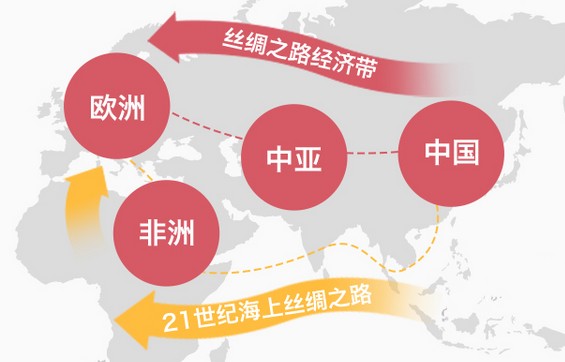“一帶一路”打造世界經(jīng)濟(jì)新引擎
Belt and Road Initiative Acts as New Engine for World Economy
來源:英語巴士 整理:泉州啟航翻譯公司
王義桅
Wang Yiwei

2016年是“一帶一路”建設(shè)全面實施之年。無論國內(nèi)還是國際社會,對“一帶一路”建設(shè)都給予了高度評價。但也有一些人對“一帶一路”建設(shè)心存疑慮,沒能正確認(rèn)識“一帶一路”建設(shè)的目標(biāo)和內(nèi)涵;也有人過分放大建設(shè)中可能遇到的問題。因此,有必要對“一帶一路”建設(shè)的目標(biāo)、內(nèi)涵以及機(jī)遇、挑戰(zhàn)等問題予以深入分析。
In 2016, the Silk Road Economic Belt and the 21st Century Maritime Silk Road will both be under construction. China, as well as the larger global community, speaks highly of the Belt and Road Initiative.
However, lacking a clear understanding of what the Belt and Road Initiative entails, some still have doubts about it. Therefore, now is a good time to conduct an in-depth analysis of the goals and larger implications of the Initiative, as well as of the opportunities and challenges that it could bring.
“一帶一路”建設(shè)既是遠(yuǎn)期的美好愿景,又是近期的實在福利。一些西方人質(zhì)疑“一帶一路”建設(shè),認(rèn)為它缺乏清晰的內(nèi)涵、路線圖,只寫意、不寫實。這種理解顯然是片面的。“一帶一路”倡議是愿景和行動的結(jié)合,是內(nèi)外發(fā)展的聯(lián)動。習(xí)近平同志指出,“一帶一路”建設(shè)不是空洞的口號,而是看得見、摸得著的實際舉措,將給有關(guān)國家和地區(qū)帶來實實在在的利益。從長期看,“一帶一路”建設(shè)著眼于促進(jìn)21世紀(jì)世界經(jīng)濟(jì)發(fā)展,踐行開放包容理念,開創(chuàng)經(jīng)濟(jì)全球化廣闊前景。從近期看,“一帶一路”建設(shè)的推進(jìn)對后國際金融危機(jī)時期各國的就業(yè)、經(jīng)濟(jì)發(fā)展等都能帶來具體而實際的好處。在沿線各國、各地區(qū)努力下,“一帶一路”建設(shè)將蓬勃發(fā)展的亞洲經(jīng)濟(jì)圈與歐洲經(jīng)濟(jì)圈連接起來,將激發(fā)巨大經(jīng)濟(jì)潛力和市場需求,打造世界經(jīng)濟(jì)發(fā)展新引擎。
The Belt and Road Initiative offers both a long-term vision and real benefits in the near future. Some Westerners believe the Initiative is nothing more than a concept, lacking a clear roadmap. However, such an interpretation is one-sided.
The Belt and Road Initiative is a combination of vision and action. As President Xi Jinping pointed out, the Initiative is not an empty slogan, but rather contains tangible measures that will benefit all the involved countries and regions.
In the long run, the Initiative will advance world economic development. It will put into practice the idea of openness and inclusiveness, and will pioneer economic globalization.
In the shorter term, the Initiative will significantly boost employment and economic development in the post-financial crisis era. With joint efforts between different countries and regions along the route, and by aligning the booming Asian economic sphere with the European one, the Belt and Road Initiative will stimulate huge market demand, acting as an engine for global economic development.
“一帶一路”建設(shè)既為中國發(fā)展提供動力,又為世界發(fā)展創(chuàng)造機(jī)遇。“一帶一路”沿線國家的經(jīng)濟(jì)總量占世界的29%,而人口占63%,前者不到后者的一半。這種經(jīng)濟(jì)總量與人口的嚴(yán)重不匹配,凸顯了“一帶一路”沿線國家發(fā)展的巨大需求缺口和潛力。因此,“一帶一路”建設(shè)源于中國而屬于世界,能夠把中國的機(jī)遇轉(zhuǎn)變?yōu)槭澜绲臋C(jī)遇。中國的現(xiàn)代化經(jīng)驗鮮活而豐富,值得發(fā)展中國家借鑒。通過基礎(chǔ)設(shè)施等建設(shè),中國將為世界提供更多公共產(chǎn)品、帶給世界更好的合作機(jī)遇,推動實現(xiàn)聯(lián)合國2030年可持續(xù)發(fā)展議程。
The Belt and Road Initiative comes from China, but it will make a difference far beyond China’s borders. China’s modernization process has set a precedent for other developing countries. Making up 63 percent of the world population, countries along the Belt and Road route only account for 29 percent of the global economic aggregate. These mismatched numbers call for drastic measures to address the gap.
科學(xué)把握“一帶一路”建設(shè)中的機(jī)遇和風(fēng)險。有人把“一帶一路”建設(shè)歪曲為中國的馬歇爾計劃,這顯然沒有讀懂中國所走的和平發(fā)展、合作共贏道路。習(xí)近平同志在多個國際場合明確表示,“一帶一路”不搞勢力范圍,而是推動大家一起加入朋友圈,編織互利共贏的合作伙伴網(wǎng)絡(luò)。當(dāng)然也要看到,“一帶一路”建設(shè)的設(shè)計構(gòu)想是實現(xiàn)共贏,但并非沒有風(fēng)險。恰恰是因為存在風(fēng)險,才更需要共商、共建、共享。我們應(yīng)客觀認(rèn)識風(fēng)險,不夸大也不小視,注重推動風(fēng)險向機(jī)遇轉(zhuǎn)化。
Meanwhile, the opportunities and risks that come with the Initiative must be viewed objectively. Some commentators have twisted the Initiative into “China’s Marshall Plan.” This misunderstanding fails to grasp China’s desire for peaceful development and mutually beneficial cooperation.
As Xi has explicitly stated on many occasions, the Belt and Road Initiative is not meant to establish a sphere of influence, but to weave a partnership network.
Of course, potential risks during the construction must be acknowledged. And it is because of those risks that the construction is being done through joint consultation, joint construction and sharing. We should neither exaggerate nor overlook these risks; an objective view is what is called for in this moment.
推進(jìn)“一帶一路”建設(shè)應(yīng)處理好三個關(guān)系。一是處理好政府與市場的關(guān)系。這是中國經(jīng)濟(jì)發(fā)展的寶貴經(jīng)驗,也適用于“一帶一路”建設(shè)。由政府推動、以企業(yè)為主體、堅持市場化運作、遵循國際標(biāo)準(zhǔn),是“一帶一路”建設(shè)的科學(xué)方法。這一方法既遵循客觀經(jīng)濟(jì)規(guī)律,也有利于打消國際社會疑慮,能夠更好地與其他國際合作架構(gòu)、發(fā)展規(guī)劃對接。二是在建設(shè)初期應(yīng)注重處理好取與予的關(guān)系。“一帶一路”沿線國家多為發(fā)展中國家,現(xiàn)階段需要更多投入,投資回報期可能較長,多予少取是“一帶一路”建設(shè)初期應(yīng)有的姿態(tài)。“一帶一路”建設(shè)是百年工程,合作共贏的思維將貫穿始終,它的推進(jìn)與我國的外交工作將互相促進(jìn)。只有堅持正確的義利觀,堅持利我與利他結(jié)合、雙邊與多邊結(jié)合、取與予結(jié)合,才能不斷延伸國內(nèi)市場,建設(shè)歐亞非大市場。三是尊重不同國家的政治體制,處理好與當(dāng)?shù)卣吧鐣M織、公眾的關(guān)系。“一帶一路”沿線國家政治體制不一。中國企業(yè)走出去,既應(yīng)重視與對方政府打交道,也應(yīng)重視與社會各層面多溝通,與當(dāng)?shù)胤钦M織打好交道。走出去的企業(yè)、團(tuán)體應(yīng)嚴(yán)格遵照絲路精神,使“一帶一路”建設(shè)更加接地氣,讓“中國制造”“中國建造”“中國服務(wù)”等進(jìn)入沿線各國尋常百姓家,向本土化的方向發(fā)展。
Looking ahead, there are three relationships that must be properly handled as the Belt and Road Initiative progresses.
The first is the relationship between the government and the market. The promotion of the Belt and Road Initiative must be government-led and enterprise-centered, while still adhering to market operations and complying with international standards.
The second relationship is the one between “give” and “take,” which must be emphasized in the initial stages of construction. Most countries along the route are developing countries. Therefore, significant investment is required at present, and the return on that investment will come later. Thus, the correct stance for now should be more “give” and less “take.” Only by maintaining this stance can we expand the domestic market into Eurasia and Africa.
Last but not least is the relationship between governmental and social organizations. Chinese enterprises that hope to go global should place emphasis on interaction with local government and non-governmental organizations. The political systems of different countries must be respected. Overseas Chinese companies should strictly abide by the Silk Road spirit; the strategy of Made in China, China Service and other brands is to strive for localization.
(作者為中國人民大學(xué)重陽金融研究院高級研究員)
(The author is a senior researcher at the Chongyang Institute for Financial Studies of Renmin University.)
相關(guān)文章:
2. 【署名文章】“一帶一路”打造世界經(jīng)濟(jì)新引擎(中英對照)















